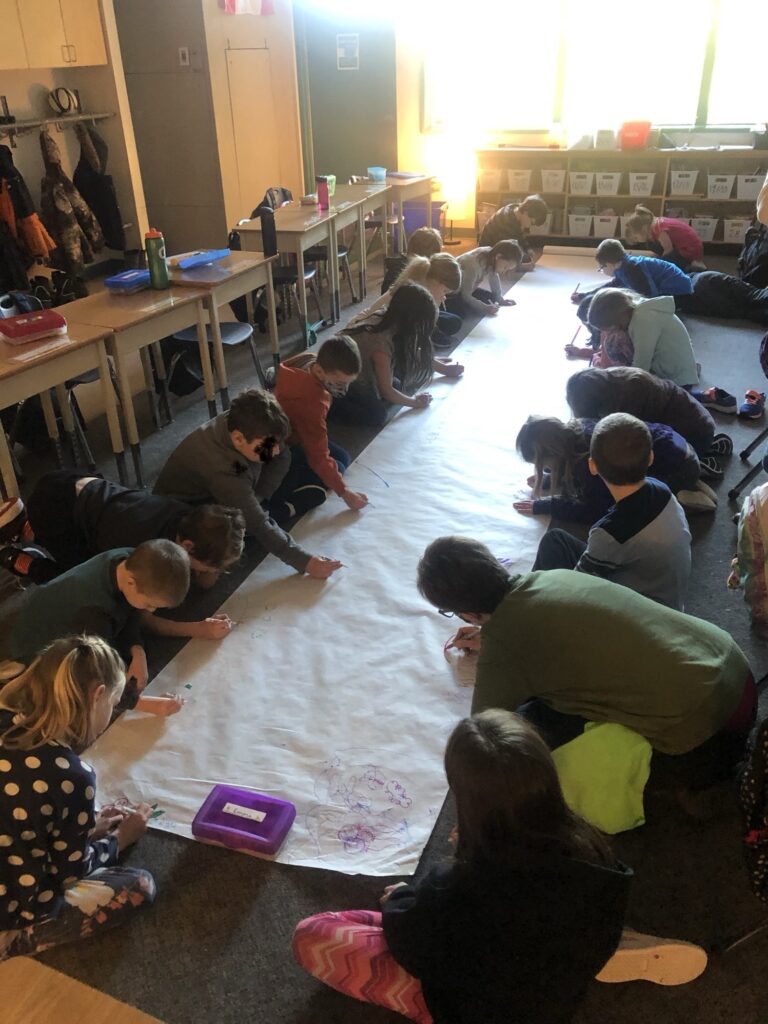In my final practicum, the student who taught me the most about inclusive education, was a little boy, K, who is autistic. He is non-verbal, but communicates minimally through an iPad, and with sounds. When I began my practicum, K was only really in our class for eating times – he loves food! Working with his amazing EA, we decided we wanted to try and get K into the classroom for longer periods of time.
Although K did not participate in “academic” work, I wanted to start by having him in the room for soft starts. I needed a soft start that the students could all work on together, at their own pace, that K could participate in. Finally I had an idea. I rolled out a long piece of paper from a paper roll, and spread it across the classroom. When my students walked in, I had each student pick a colour that was different from that of their neighbour. I gave the students a theme (themes we did were the local landscape, Mars, deep sea, our town, a zoo) and each student picked a spot around the paper and began colouring. I played music, and when the music stopped, the students had to rotate spots and begin working on the image their neighbour had started. K absolutely thrived. He liked that he got to move around the paper, and holding a marker to draw and scribble was a task he was very capable of. The other students would pat the ground to show him where to move when the music stopped. My EA and I stood there in awe the first day that I tried this soft start. It was beautiful.
Next, K started coming into the class for movement breaks. We learned that he absolutely loves music and dancing, so when my students were getting wiggle-y I would send a runner to grab K and his EA, and we would do Just Dance videos together. K loved it! He could not follow the dance moves, but dancing with his classmates and teachers made him smile from ear to ear. He was always so excited to dance. As he loved moving, he started coming outside for Outdoor PE with the class. The other students loved having him play outside with them, and he loved playing the games with them.
Finally, the chick unit began in Science. K was FASCINATED by the chicks. When we would do chick holding and observations, he was always in the room to watch and pet the chicks. He learned to be gentle and careful. With my coaching teacher and K’s EA, we communicated his love of chicks to his parents. They had had chickens long before K was born but the coop had been empty for years. They decided to fix it up and get some chickens of their own! It was a beautiful development in our story.
My time teaching and learning with K has been amazing. He has taught me more than I could ever expect, and I am overjoyed to have him spending so much time in our classroom – as are the other students! The beauty of the adaptations I have made for K, are that they have benefited each of the other students, and created a fun and positive environment for us all.
Thank you, K.
A few links to refer to for information on Inclusive Education:
What is Inclusive Education? – from Inclusive Education Canada
https://inclusiveeducation.ca/about/what-is-ie/
What is Inclusive Education? – From Inclusion BC
https://inclusionbc.org/our-resources/what-is-inclusive-education/
Inclusive Education Resources – BC Ministry of Education
https://www2.gov.bc.ca/gov/content/education-training/k-12/teach/teaching-tools/inclusive-education
Special Education Policy Manual PDF – BC Ministry of Education
https://www2.gov.bc.ca/gov/content/education-training/k-12/teach/teaching-tools/inclusive-education
Teachers of Inclusive Education (TIE) – British Columbia
http://www.tiebc.com/
SOGI 123 – British Columbia
https://bc.sogieducation.org/

Pictured: K joining his classmates for a morning soft start.